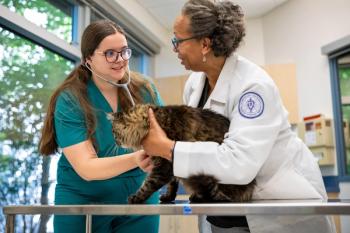
- dvm360 August 2020
- Volume 51
- Issue 8
Alternative therapies for managing osteoarthritis
Osteoarthritis is a painful, debilitating condition that affects countless animals. Here’s a look at alternative treatments being used in veterinary practices across the country.
The goals of osteoarthritis (OA) management in companion animals are aimed at improving quality of life by controlling pain and restoring mobility to the extent possible. Traditional modalities for accomplishing these goals include dietary manipulation, physical therapy, surgery, and pharmaceutical agents (nonsteroidal anti-inflammatory drugs, corticosteroids, disease-modifying osteoarthritic drugs, nutraceuticals).
But veterinary clients are inquiring with increasing frequency about alternative modalities for managing OA in their pets. As veterinarians, we hold the keys to safe and effective treatments for patients suffering from this debilitating disease. Here’s a brief overview of some alternative modalities that can be used for primary or adjunctive OA management.
Nutrition
The connection between OA and overweight/obesity is undeniable. According to Banfield’s
A number of
Acupuncture
The use of
Multiple techniques, including dry needling, aquapuncture, moxibustion, electroacupuncture, and laser acupuncture, may be used either alone or in combination to stimulate acupoints. Aquapuncture is the introduction of sterile fluid into an acupoint as an alternative to setting dry needles. Moxibustion incorporates the burning of moxa (small cones of dried herbs) to apply heat safely to acupoints. Electroacupuncture, which combines mechanical and electrical effects, is commonly used to relieve pain associated with OA.4 Laser acupuncture involves the use of a low-intensity laser to stimulate acupoints. Laser acupuncture and aquapuncture are ideal for patients that cannot tolerate dry needling or electroacupuncture.
Herbal formulations
A number of Chinese herbal formulations containing boswellia and turmeric have been proven safe and effective for reducing OA pain and inflammation in dogs.5,6 In my experience, Chinese herbal formulations are best used in combination with acupuncture to increase the effectiveness of treatment.
Stem cells
Commercially available autologous adipose-derived mesenchymal
Cannabinoids
Research on the use of
Conclusion
The prevalence of OA, combined with a shift in client perceptions and the desire to treat with alternative modalities, pose a unique challenge to veterinarians. The good news is that safely and effectively improving quality of life in these patients is now possible when surgery and pharmaceuticals are not options. As always, the modalities selected should be tailored to the patient's specific needs and the owner's ability to remain consistent in their role as caregiver.
References
- Osteoarthritis: When age is not to blame. Banfield Pet Hospital. Published January 2020. Accessed August 6, 2020.
https://www.banfield.com/Banfield/media/PDF/Downloads/soph/2019-SOPH-Report.pdf - Smith GK, Paster ER, Powers MY, et al. Lifelong diet restriction and radiographic evidence of osteoarthritis of the hip joint in dogs. J Am Vet Med Assoc. 2006;229(5):690-693. doi: 10.2460/javma.229.5.690
- Davies M. Practical management of canine osteoarthritis. Vet Times. Published January 19, 2015. Accessed August 1, 2020.
https://www.vettimes.co.uk/app/uploads/wp-post-to-pdf-enhanced-cache/1/practical-management-of-canine-osteoarthritis.pdf - Zhang R, Lao L, Ren K, Berman BM. Mechanisms of acupuncture-electroacupuncture on persistent pain. Anesthesiology. 2014;120(2):482-503. doi:10.1097/ALN.0000000000000101
- Dejonckheere V. Turmeric for osteoarthritis in veterinary medicine: a review. (2016). Herbal Vets. Published 2016. Accessed August 1, 2020.
http://www.herbalvets.org.uk/wp-content/uploads/2016/10/turmeric-dejonckheere.pdf - Miscioscia E, Shmalberg J,Scott KC. Measurement of 3-acetyl-11-keto-beta-boswellic acid and 11-keto-beta-boswellic acid in Boswellia serrata supplements administered to dogs. BMC Vet Res. 2019;15;270. https://doi.org/10.1186/s12917-019-2021-7
- Black LL, Gaynor J, Gahring D, et al. Effect of adipose-derived mesenchymal stem and regenerative cells on lameness in dogs with chronic osteoarthritis of the coxofemoral joints: a randomized, double-blinded, multicenter, controlled trial. Vet Ther. 2007;8(4):272-284.
- Shah K, Drury T, Roic I, et al. Outcome of allogeneic adult stem cell therapy in dogs suffering from osteoarthritis and other joint defects. Stem Cells Int. 2018;7309201. doi: 10.1155/2018/7309201
- Verrico CD, Wesson S, Konduri V, et al. A randomized, double-blind, placebo-controlled study of daily cannabidiol for the treatment of canine osteoarthritis pain [published online ahead of print, 2020 Apr 24]. Pain. 2020;10.1097/j.pain.0000000000001896. doi:10.1097/j.pain.0000000000001896
Articles in this issue
over 5 years ago
Gene editing in animals: Miracle or madness?over 5 years ago
Compassion-First adds 43rd veterinary practiceover 5 years ago
First diagnostic test for canine IBD now availableover 5 years ago
FDA approves generic carprofen chewable for dogsover 5 years ago
When cats get hangry…over 5 years ago
Why we need more veterinary colleges at HBCUsover 5 years ago
DNA debunks age-old ratio for dog years to human yearsover 5 years ago
Quiet, please!Newsletter
From exam room tips to practice management insights, get trusted veterinary news delivered straight to your inbox—subscribe to dvm360.





